Artículos
Applying Interpretive Structural Modeling and MICMAC Analysis to Evaluate Inhibitors to Transparency in Humanitarian Logistics
Aplicación de modelos estructurales interpretativos y análisis MICMAC para evaluar inhibidores de la transparencia en la logística humanitaria
Applying Interpretive Structural Modeling and MICMAC Analysis to Evaluate Inhibitors to Transparency in Humanitarian Logistics
Utopía y Praxis Latinoamericana, vol. 25, no. Esp.2, pp. 325-337, 2020
Universidad del Zulia

This work is licensed under Creative Commons Attribution-NonCommercial-ShareAlike 3.0 International.
Received: 22 March 2020
Accepted: 30 April 2020
Abstract: The main purpose of this study is to identify the variables for the lack of transparency in humanitarian logistics (HL) and to determine their mutual relationship. The interpretive structure modeling (ISM) method was applied to extend a hierarchy- based model of the identified variables. The study makes two key contributions: the variables that can be reflected as inhibitors to transparency in HL are determined, and the ISM methodology is used to determine the group of variables that have full control, low reliance and strategic importance. The study findings are beneficial for all stakeholders of disaster risk reductions.
Keywords: Humanitarian logistics, information sharing, interpretive structural modelling, transparency..
Resumen: El objetivo principal de este estudio es identificar las variables por la falta de transparencia en la logística humanitaria (HL) y determinar su relación mutua. El método de modelado de estructura interpretativa (ISM) se aplicó para extender un modelo basado en la jerarquía de las variables identificadas. El estudio hace dos contribuciones clave: se determinan las variables que pueden reflejarse como inhibidores de la transparencia en HL, y la metodología ISM se utiliza para determinar el grupo de variables que tienen control total, poca dependencia e importancia estratégica. Los resultados del estudio son beneficiosos para todos los interesados en la reducción del riesgo de desastres.
Palabras clave: Logística humanitaria, intercambio de información, modelación estructural interpretativa, transparencia..
INTRODUCTION
Disasters badly disturb the concern population and lead to human, material and financial losses that are difficult for a population’s capacity by applying its resources to control the situation. In the past several years in developing countries, almost two thousand million people have affected due to hazards related to climate change (Khan et al.: 2019, p. 2078; Khan et al.: 2019a, p. 450). In relief operations (RO), the central position is occupied by HL (Vitoriano et al.: 2011, pp. 189-208), as the cost and participation of logistics account for almost 80% of the total RO whereas, HL constantly has minimum attention within organizations (Khan et al.: 2019 p. 2078).
The increasing magnitude and several disasters, the shortage of resources and the competition for resources combine to escalate the significance of effective, efficient and fair HL (Larrea: 2013, pp. 211-216; Khan et al.: 2019, p. 2078). In logistics, information sharing increases the capital of organizations and the effectiveness RO (Anjomshoae et al.: 2017, pp. 194-218; Khan et al.: 2019b, p. 549). Effective HL not only decreases delivery time, risk and cost, but can also save lives and decrease people devastating. Therefore, HL should be fair. The study of (Khan et al.: 2019, p. 2078) concentrated on transparency in the HL context but the inhibitors to transparency in the HL context never been examined in the literature before. Therefore, the key objective of this research is to present variables for the lack of transparency information in HL and to determine their mutual relationship. This study contributes to the knowledge of these variables, which can be known as inhibitors to transparency in HL. The study findings contribute to the present theories and introduce the guidelines for more improvement in disaster relief operations (DRO). Practical implications are presented, and research gaps are explored.
METHODS
Transparency is not simply about what has shared the good information outside in an organization (Parris et al.:2016, pp. 222-247), but also what is real inside the organization (Park & Blenkinsopp: 2011, pp. 254- 274). Transparency is a way to enhance organizational performance (Wehmeier & Raaz: 2012, pp. 337-366)and extend democratic practice (Baraibar‐Diez et al.: 2017, pp. 480-489).
Temporary workers and lack of expert logisticians are obstacles in the way of transparency. Furthermore,HOs call for greater transparency but lack of monitoring (Bealt & Mansouri: 2017) and accountability, further complicates the transparency process (Scarpin & de Oliveira Silva: 2014, pp. 102-111; Mohammadi & Yekta: 2018, pp. 1-7) stated that short-term relationships of HOs in the process of HL with other stakeholders and the organization size (small & medium) have no fear of transparency. In HL, uncommon language and lack of communication impede transparency. To handle the donors’ pressure, HOs attempt to gain the attention of media and favor some specific groups to evade complaints. Consequently, corruption, multiple stakeholders, mismanagement, political interference, donor behaviors, lack of technology, improper routing and competition for funding impedes transparency. Uncertainty, urgency and the complexity of disaster assistance directly affect the transparency process in HL (Bealt & Mansouri: 2017).
The transformation of HL process into transparent one is no easy task. 16 very relevant variables were identified and were grouped through a brainstorming technique. With the consensus among the participants regarding these 16 variables, the inhibitors were applied to extend the ISM based model as seen in Figure 1.
Ism methodology and building the ism model
The brainstorming section above reveals several variables; they are inhibitors to transparency in HL. It is very important to know the contextual relationship among these variables. The best possible way to achieve this by applying interpretive structure modeling (ISM) methodology, which can effectively bring forward these interrelationships. These following steps are considering in this method.
Step i. The variables impacting transparency in HL are identified through brainstorming technique
Step ii. A structural relationship is constructed among the identified variables
Step iii. A structural self-interaction matrix (SSIM) is framed for the variables, reflecting the doublet relationships of the inhibitors of the structure under consideration. (See Table 1)
Step iv. A reachability matrix is framed from the SSIM, then scanned for transitivity. (See Table 2)
Step v. In this step, the framed reachability matrix is further subdivided into 8 levels. (See table 3 to 11 Iteration i-ix)
Step vi. In this step from the reachability matrix, a direct graph is drawn, and the associations of transitive are detached. (see Figure 2)
Step vii. The digraph drawn in the previous step is transformed into an ISM model, by putting nodes ofinhibitors with statements. (See Figure 1)
Step viii. The ISM model is examined for any necessary modification and any conceptual inconsistencies.
APPLICATION OF THE PROPOSED APPROACH
Structural Self-Interaction Matrix (Ssim)
Considering the related relation for each inhibitor, the presence of a link between any two inhibitors (i and j) and the related order of the association is examined. Four indications are utilized to represent the direction of the relation between the inhibitors (i and j):
V: inhibitor i will intensify inhibitor j; A: inhibitor i will be intensified by inhibitor j; X: inhibitor i and j will intensify each other; and O: inhibitor i and j are independent.
Accordingly, the indications V, A, X, and O in Table 1, are used to portray the nature and existence oflinks between the 16 variables. Some cases are given below.
Inhibitor 1 (bad governance) intensifies inhibitor 2 (lack of accountability). When there is bad governance there will be a lack of accountability. This relationship in Table 2 is represented by an indication V.
Inhibitor 4 “lack of communication” is intensified by inhibitor 16 “disaster constraints”. If the magnitude of a disaster is high, there will be difficult to communicate and coordinate among stakeholder from the disaster site. Therefore, the indication is A.
Inhibitor 5 “Lack of performance measurement” and inhibitor 15 “Financial constraints” intensify and affect each other. If there are financial constraints, it is difficult to measure performance. On the other hand, in terms of HL, if there is a lack of performance measurement, the donors will not trust the organization. So, it is difficult to get funds. This association is represented by indication X.
Inhibitor 6 “Lack of long-term relationships” and inhibitor 14 “Lack of IT” has no relationship, revealed by O.
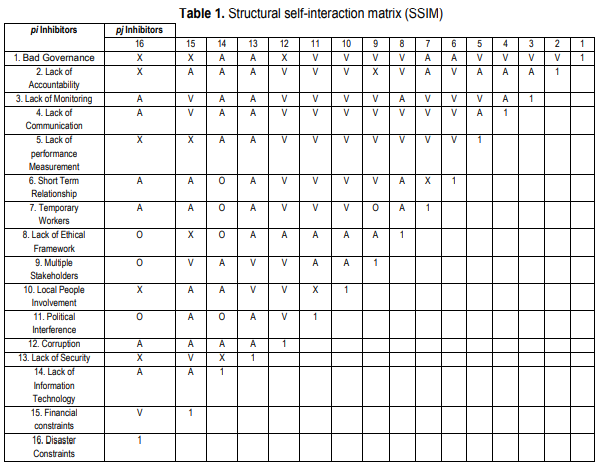
Reachability Matrix
The fourth phase is the transformation of the SSIM into the primary reachability matrix by taking the place of the 4 symbols of SSIM (e.g., V, A, X or O) at 1s or 0s.
For this substitution (V, A, X, O by 1 or 0 as suitable) the rules are as follows:
- 1. In the SSIM, if the (i, j) symbol is V, then the (i, j) digit in the reachability matrix should be 1 and the (j,i) digit should be 0.
- 2. If the (i, j) symbol in the SSIM is A, then the (i, j) digit in the reachability matrix should be 0 and the (j,i) digit should be 1.
- 3. If the (i, j) symbol in the SSIM is X, then the (i, j) digit in the reachability matrix becomes 1 and the (j,i) digit should also be 1.
- 4. If the (i, j) symbol in the SSIM is O, then the (i, j) digit in the reachability matrix should be 0 and the (j,Importar listai) digit should also be 0.
Subsequently, the rules are to construct the final reachability matrix, after incorporating the transitivity (as if an inhibitor L is connected to M and M connected to N, therefore L and N are connected), as seen in Table 2.
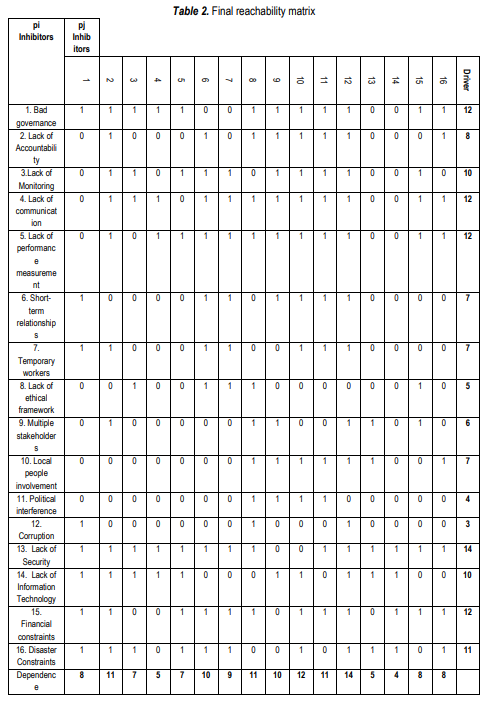
In Table 2, the driver and the dependence of each variable are presented. Both of these powers are applied in the Matrices d’Impacts cross-multiplication appliqúe a classmate (MICMAC) (cross-impact matrix multiplication applied to classification) examination.

Level partitions
From Table 2, for each variable, reachability and antecedent sets can be obtained. The reachability set includes the variables itself and the other variables that they may influence. Therefore, for every variable pi, reachability can be defined by setting R (pi) as the set of variables reachable from pi. R (pi) can be determined by examined the row of interest in Table 2, of the final reachability matrix regarding pi. Similarly, the variable that the column represents is then included in a suitable row in R (pi) column in the table of Iteration.
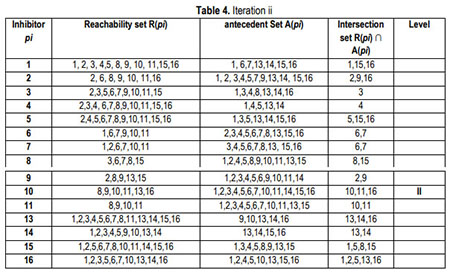
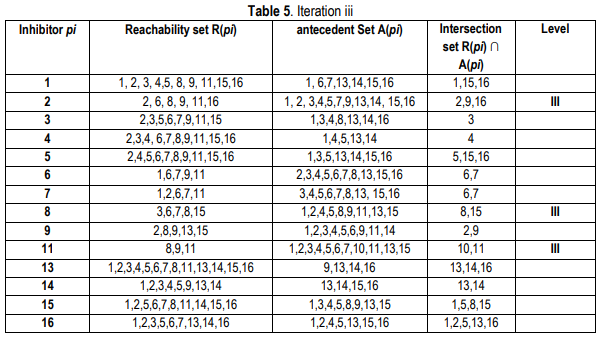
In the hierarchy, variable number 12 which is corruption is on top. Subsequently, the reachability set for a top-level element pi consists of the element itself and any other elements within the same level which the element may reach, such as the components of a strongly connected subset.
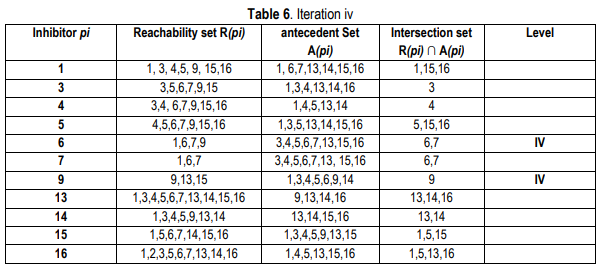
Afterward, the intersection of these variables sets is obtained for the entire variables and the levels of different variables are determined. The variables for which the sets of reachability and the intersection are the same is captured at the top level of the ISM hierarchy.
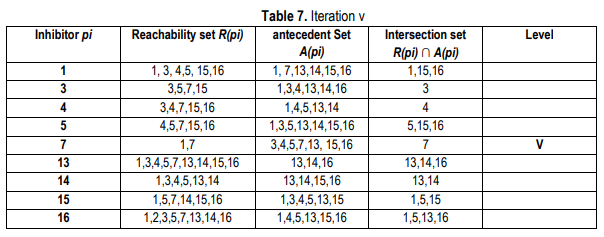
The top-level variables are those variables that do not influence the other variables above their level in the hierarchy. Subsequently, the intersection of the sets of reachability and the antecedent is the same as the set of reachability is at the top level.
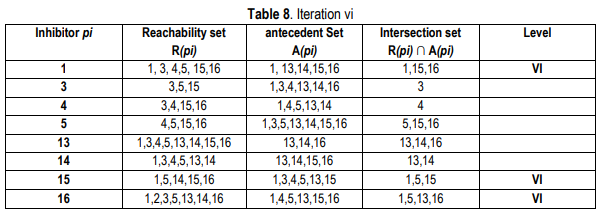

As soon as the top-level inhibitors are recognized, it is detached from the matrix. After, a similar process is repeated to identify the inhibitors in the coming level. The procedure is continued until the level of each inhibitor is developed, as can be seen in Tables 3, to Table 11. These levels are useful in establishing the graph and the ISM Model.

RESULTS
Building the ISM-based model
Several variables affect the transformation of HL into a transparent HL. Therefore, this is one of the complicated issues. These variables are in proper order and direction in the ISM model and express the current situation instead of any single variable considered in isolation. Therefore, ISM is a perfect approach because it provides a complete structure of the variables. This approach brings forward the invisible and poorly structure models into a clear, transparent and comprehensive system as presented graphically. From Table 2, the structural model is derived via lines of edges and vertices or nodes. This model is represented by a digraph as seen in figure 2. Finally, the digraph is transformed into the ISM model as presented in Figure 1. The relationship between two variables (j to i, i to j) is indicated by an arrow.
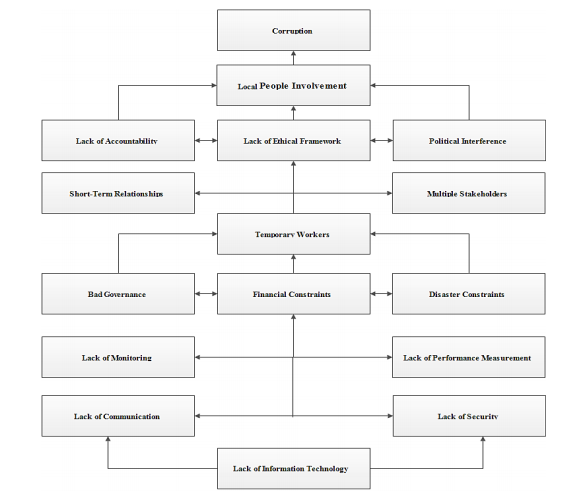
Figure 1. ISM-based model for inhibitors to Transparency in HL
MICMAC analysis
This section examines the driver and the reliance of the inhibitors, which is the main purpose of MICMAC analysis (Faisal: 2010, pp. 179-195). These inhibitors are categorized into 4 different quadrants (Figure 2). The first quadrant is called the autonomous with holders. They have very weak driver power and reliance and mostly out of the system. The second quadrant contains the dependent variables. They have very strong reliance but very weak driver power. The third quadrant consists of the linkage inhibitors that have not only strong driving power but also strong dependence. These variables are uniquely unsteady because any action on these variables will affect the others and also themselves. The fourth quadrant contains independent inhibitors. They have very strong driving power but very weak dependence. A variable that has very strong driving power is considered a key variable (Table 2). Out of the 16 variables, no variable falls in quadrant 1 and quadrant 3, whereas 7 variables fall in quadrant 2 and 9 in quadrant 4. It means that most of the variables have strong driving power as discussed next.
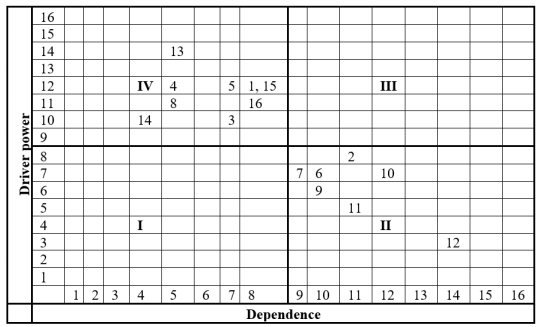
The fair sharing of available resources (Anaya-Arenas et al.: 2014, pp. 53-79) security, transparency (Gould et al.: 2010, pp. 287-302), monitoring, (Heaslip & Barber: 2014, pp. 60-81), the use of advance technology and effective communication lead to fast, fair and safe HL (Beamon & Balcik: 2008, pp. 4-25). Nevertheless, economic constraints (Khan & Bae: 2017, pp. 1-16), rampant corruption (Khan et al.: 2018, p. 63), bad governance, and political influence, lead to a low level of fair distribution (Ahmeda, 2013). Lack of transparency also decreases the efficiency and effectiveness of HL (Turnes & Ernst: 2015,
As in Figure 2, the variables are divided into 4 different quadrants. All variables fall in the dependent and independent categories and all of them are very important to be considered. In quadrant 2, 7 variables are having high-value reliance but have low power control. This is very true for these variables, as observed in the literature. The last group (quadrant 4) consists of 9 variables having very high driving power and low reliance, it indicates not only the importance of these variables but also their position as originators of the issue.
CONCLUSION
The study has identified 16 basic inhibitors by studying relevant existing literature and through brainstorming methods. This study is applied ISM approach to extend an interrelationship model for the inhibitors to transparency in HL. MICMAC analysis is used to recognize the driver and reliance of inhibitors to transparency applying the ISM approach. Diagraph in figure 2, reflects that information technology, security and communication are three important inhibitors to transparency having high driving power. So, management needs to focus on the identified inhibitors for proper implementation of transparency in HL. As mentioned, in this study integrated hierarchal model of transparency is extended that can be supportive to HOs to apply this model for identifying and classifying the importance of transparency of their needs and to denote the influence either direct or indirect of each inhibitor on the transparency implementation. Therefore, this study could add to the existing literature on HL and could support to know the basic causes behind the implementation of transparency in HL. The study has contributed to bringing the fair distribution of relief items which can further enhance the effectiveness of HL.
BIODATA
MUHAMMAD KHAN is working as a lecturer at Abdul Wali Khan University Mardan, Pakistan in the department of Management Sciences since 2011. He completed his Ph.D. from Yeungnam University South Korea and Master from American College Dublin, Ireland in International Business. His area of interest is Humanitarian Supply Chain and Logistics and he published several research papers in reputed international and national journals.
ARIF HUSSAIN is serving as an assistant professor in Abdul Wali Khan University Mardan, Pakistan. He received his Ph.D. degree in management science from Islamia College University, Pakistan. His areas of interest are supply chain management, quality management, project management, and financial administration. He has published several research papers in journals of high r
NAVEED FAROOQ is serving as an assistant professor in Abdul Wali Khan University, Mardan. Pakistan. He received his Ph.D. Degree in Management Science from Islamia College University, Pakistan. His area of interest is compensation management, recruitments, and selection. He has published research papers in various national and international research journals.
SHEHNAZ SAHIBZADA is serving as lecturer and Ph.D. scholar at Abdul Wali Khan University Mardan, Pakistan. Her area of interest is a human resource management and published research papers in journals of high repute.
SHUMAILA MALIK is serving as an assistant professor at Northern University Nowshera, Pakistan. She is pursuing a PhD from Northern University Nowshera. Her area of interest is marketing management.
ASIYA KHATTAK is serving as a lecturer in Northern University Nowshera, Pakistan. She is pursuing her Ph.D. in management science from the Institute of Business Studies and Leadership, Abdul Wali Khan University Mardan. Her area of interest is strategic management and international trade.
BIBLIOGRAPHY
AHMEDA, Z (2013). "Disaster risks and disaster management policies and practices in Pakistan: Acritical analysis of Disaster Management Act 2010 of Pakistan". International Journal of Disaster risk management. Queen Mary, University of London, UK.
ANAYA-ARENAS, AM, RENAUD, J & RUIZ, A (2014). "Relief distribution networks: a systematic review". Annals of Operations Research, 223(1), pp. 53-79.
ANJOMSHOAE, A, HASSAN, A, KUNZ, N, WONG, KY & DE LEEUW, S (2017). "Toward a dynamic balancedscorecard model for humanitarian relief organizations’ performance management". Journal of Humanitarian Logistics and Supply Chain Management, 7(2), pp. 194-218.
BARAIBAR‐DIEZ, E, ODRIOZOLA, MD, & FERNÁNDEZ SÁNCHEZ, JL (2017). "A Survey of Transparency:An Intrinsic Aspect of Business Strategy". Business Strategy and the Environment, 26(4), pp. 480-489.
BEALT, J & MANSOURI, SA (2017). "From disaster to development: a systematic review of community‐drivenhumanitarian logistics". Disasters.
BEAMON, BM & BALCIK, B (2008). "Performance measurement in humanitarian relief chains". International Journal of Public Sector Management, 21(1), pp. 4-25.
FAISAL, MN (2010). "Analysing the barriers to corporate social responsibility in supply chains: an interpretive structural modelling approach". International Journal of Logistics: Research and Applications, 13(3), pp. 179- 195.
GOULD, JE, MACHARIS, C & HAASIS, HD (2010). "Emergence of security in supply chain management literature". Journal of Transportation Security, 3(4), pp. 287-302.
HEASLIP, G & BARBER, E (2014). "Using the military in disaster relief: systemising challenges and opportunities". Journal of Humanitarian Logistics and Supply Chain Management, 4(1), pp. 60-81
KHAN, M & BAE, JH (2017). "The Environmental Perspectives of Apple Fruit Supply Chain Management in Chitral, Northern Pakistan". International Journal of Supply Chain Management, 6(4), pp. 1-16.
KHAN, M, LEE, HY & BAE, JH (2018). "Inward Foreign Direct Investment: A Case Study of Pakistan". Mediterranean Journal of Social Sciences, 9(5), p. 63.
KHAN, M, LEE, HY & BAE, JH (2019). "The Role of Transparency in Humanitarian Logistics". Sustainability, 11(7), p. 2078.
KHAN, M, YONG, LH & HAN, BJ (2019a). "Emerging Techniques for Enhancing the Performance of Humanitarian Logistics". Int. J Sup. Chain. Mgt, 8(2), p. 450.
KHAN, M, YONG, LH & HAN, BJ (2019b). "A Systematic Review of Performance Enhancement of Humanitarian Logistics through Transparency: Current Status and Perspectives". Int. J Sup. Chain. Mgt, 8(2), p. 549.
LARREA, O (2013). "Key performance indicators in humanitarian logistics in Colombia". IFAC Proceedings Volumes, 46(24), pp. 211-216.
MOHAMMADI, S & YEKTA, P (2018). "The Effect of Emotional Intelligence on Job Satisfaction among Stuff Nurses in Intensive Care Units". Journal of Social Sciences and Humanities Research, 6(02), pp. 1-7.
PARK, H & BLENKINSOPP, J (2011). "The roles of transparency and trust in the relationship between corruption and citizen satisfaction". International Review of Administrative Sciences, 77(2), pp. 254-274.
PARRIS, DL, DAPKO, JL, ARNOLD, RW & ARNOLD, D (2016). "Exploring transparency: a new framework for responsible business management". Management Decision, 54(1), pp. 222-247.
SCARPIN, MRS & DE OLIVEIRA SILVA, R (2014). "Humanitarian logistics: empirical evidences from a natural disaster". Procedia Engineering, 78, pp. 102-111.
TURNES, PB & ERNST, R (2015). "A framework for transparency in international trade". Investigaciones Europeas de Dirección y Economía de la Empresa, 21(1), pp. 1-8.
VITORIANO, B, ORTUÑO, MT, TIRADO, G & MONTERO, J (2011). "A multi-criteria optimization model for humanitarian aid distribution". Journal of Global Optimization, 51(2), pp. 189-208.
WEHMEIER, S & RAAZ, O (2012). "Transparency matters: The concept of organizational transparency in the academic discourse". Public Relations Inquiry, 1(3), pp. 337-366.
